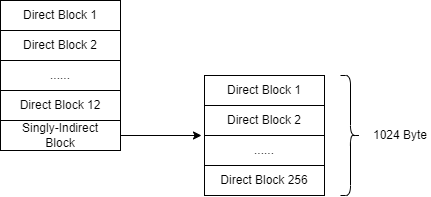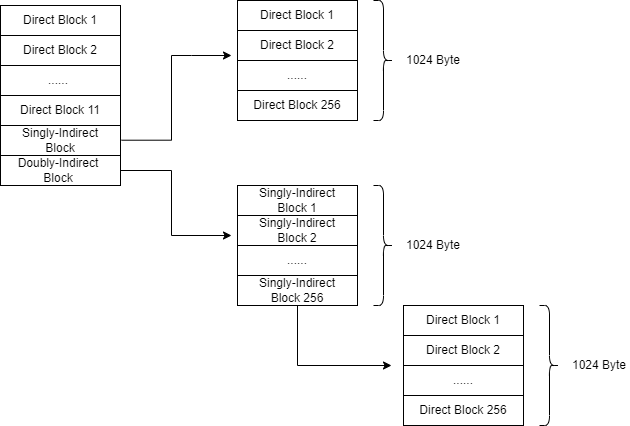9. Lab: file system
1. Large files (moderate)
1.1 要求
Modify bmap() so that it implements a doubly-indirect block, in addition to direct blocks and a singly-indirect block. You'll have to have only 11 direct blocks, rather than 12, to make room for your new doubly-indirect block; you're not allowed to change the size of an on-disk inode. The first 11 elements of ip->addrs[] should be direct blocks; the 12th should be a singly-indirect block (just like the current one); the 13th should be your new doubly-indirect block. You are done with this exercise when bigfile writes 65803 blocks and usertests runs successfully:
要求扩大 xv6 中文件大小上限。目前 xv6 文件限制为 268 个块,或 268*BSIZE 字节(在 xv6 中 BSIZE 为 1024)。 因为一个 xv6 inode 包含 12 个“直接”块号和一个“单独间接”块号,这是指一个块最多可以容纳 256 个块号,总共 12+256=268 块。
因此需要更改 xv6 文件系统代码以支持每个 inode 中的“双重间接”块,其中包含 256 个单间接块地址,每个块最多可包含 256 个数据块地址。 结果将是一个文件将能够包含多达 65803 个块,或 256*256+256+11 个块(11 个而不是 12 个,因为我们将为双间接块牺牲一个直接块号)
原来的结构如图下:

修改后的结构应当如下:

可以看到,有点类似多级页表的思路。
1.2 分析
要注意的点如下:
- 因为
inode.addrs固定为13 个,因此需要减少一个DirectBlock给Doubly-Indirect使用 bmap的函数签名如右:bmap(struct inode *ip, uint bn),bn为 block number。需要注意,当bn大于 256 + 11 的时候,需要开始在Doubly-Indirect中找到合适的Direct-Block,可以通过bn=bn-256-11去掉偏移,然后bn/256得到在第几块Singly-Indirect,bn%256得到目标块在Singly-Indirect中的偏移。- 通过
bread获取buf之后,修改buf后需要通过log_write操作写入更新。
1.3 实现
- 修改直接块数量,注意需要修改
dinode和inode的addrs大小
#define NDOUBLEINDIRECT (NINDIRECT * NINDIRECT)
#define NDIRECT 11
// On-disk inode structure
struct dinode {
short type; // File type
short major; // Major device number (T_DEVICE only)
short minor; // Minor device number (T_DEVICE only)
short nlink; // Number of links to inode in file system
uint size; // Size of file (bytes)
uint addrs[NDIRECT+2]; // Data block addresses
};
// in-memory copy of an inode
struct inode {
uint dev; // Device number
uint inum; // Inode number
int ref; // Reference count
struct sleeplock lock; // protects everything below here
int valid; // inode has been read from disk?
short type; // copy of disk inode
short major;
short minor;
short nlink;
uint size;
uint addrs[NDIRECT+2];
};
- 分配间接块,此处需要注意,只有当用到时才分配块,其次修改块时需要记得
log_write
static uint
bmap(struct inode *ip, uint bn)
{
uint addr, *a;
struct buf *bp, *inbp;
if(bn < (NDIRECT)){
if((addr = ip->addrs[bn]) == 0)
ip->addrs[bn] = addr = balloc(ip->dev);
return addr;
}
bn -= NDIRECT;
if(bn < NINDIRECT){
// Load indirect block, allocating if necessary.
if((addr = ip->addrs[NDIRECT]) == 0)
ip->addrs[NDIRECT] = addr = balloc(ip->dev);
bp = bread(ip->dev, addr);
a = (uint*)bp->data;
if((addr = a[bn]) == 0){
a[bn] = addr = balloc(ip->dev);
log_write(bp);
}
brelse(bp);
return addr;
}
bn -= NINDIRECT;
// load doublely-indirect block
if(bn < NDOUBLEINDIRECT){
if((addr = ip->addrs[NDIRECT + 1]) == 0)
ip->addrs[NDIRECT + 1] = addr = balloc(ip->dev); // alloc doublely-indirect block
// get indirect block index
inbp = bread(ip->dev, addr);
a = (uint*)(inbp->data);
uint in_index = bn / NINDIRECT;
uint bn_index = bn % NINDIRECT;
// Load indirect block, allocating if necessary.
if ((addr = a[in_index]) == 0){
a[in_index] = addr = balloc(ip->dev);
log_write(inbp);
}
brelse(inbp);
bp = bread(ip->dev, addr);
a = (uint*)bp->data;
if ((addr = a[bn_index]) == 0){
a[bn_index] = addr = balloc(ip->dev);
log_write(bp);
}
brelse(bp);
return addr;
}
panic("bmap: out of range");
}
- 释放块
// Truncate inode (discard contents).
// Caller must hold ip->lock.
void
itrunc(struct inode *ip)
{
int i, j, k;
struct buf *bp, *inbp;
uint *a;
uint *tmp;
for(i = 0; i < NDIRECT; i++){
if(ip->addrs[i]){
bfree(ip->dev, ip->addrs[i]);
ip->addrs[i] = 0;
}
}
if(ip->addrs[NDIRECT]){
bp = bread(ip->dev, ip->addrs[NDIRECT]);
a = (uint*)bp->data;
for(j = 0; j < NINDIRECT; j++){
if(a[j])
bfree(ip->dev, a[j]);
}
brelse(bp);
bfree(ip->dev, ip->addrs[NDIRECT]);
ip->addrs[NDIRECT] = 0;
}
if(ip->addrs[NDIRECT + 1]){
inbp = bread(ip->dev, ip->addrs[NDIRECT + 1]);
a = (uint*)(inbp->data);
for (j = 0; j < NINDIRECT; j++){
if (a[j]) {
bp = bread(ip->dev, a[j]);
tmp = (uint*)bp->data;
for(k = 0; k < NINDIRECT; k++){
if(tmp[k])
bfree(ip->dev, tmp[k]);
}
brelse(bp);
bfree(ip->dev, a[j]);
a[j] = 0;
}
}
brelse(inbp);
bfree(ip->dev, ip->addrs[NDIRECT + 1]);
ip->addrs[NDIRECT + 1] = 0;
}
ip->size = 0;
iupdate(ip);
}
2. Symbolic links(moderate)
2.1 要求
You will implement the symlink(char *target, char *path) system call, which creates a new symbolic link at path that refers to file named by target. For further information, see the man page symlink. To test, add symlinktest to the Makefile and run it. Your solution is complete when the tests produce the following output (including usertests succeeding).
实现 symlink 接口,比较简单,与 link 的区别在于,symlink 会创建文件,而 link 接口只是增加目标文件的引用计数,并写入目录。
2.2 分析
实现主要有 2 点:
- 创建链接文件,通过
sys_symlink接口创建 - 访问链接文件,通过
sys_open访问
2.3 实现
- 创建文件
在 inode 结构中增加 char symlinkpath[128];,用于存储目标文件的名字。
uint64 sys_symlink(void)
{
char path[MAXPATH], target[MAXPATH];
struct inode *ip;
if(argstr(0, target, MAXPATH) < 0 || argstr(1, path, MAXPATH) < 0)
return -1;
begin_op();
if ((ip = namei(path)) == 0){
ip = create(path, T_SYMLINK, 0, 0);
if (ip == 0){
end_op();
return -1;
}
}else if (ip->type != T_SYMLINK){
end_op();
return -1;
}else{
ilock(ip);
}
memset(ip->symlinkpath, 0, MAXPATH);
memmove(ip->symlinkpath, target, sizeof(target));
iunlockput(ip);
end_op();
return 0;
}
- 访问文件
需要注意如果有 O_NOFOLLOW 的 flag,则直接访问链接文件,而不是访问 inode.symlinkpath 的文件。
其次要注意存在链接文件 链接 链接文件的操作,有点套娃,比如 a->b,b->c,c->a,此时如果没有防范措施会无限套娃,因此根据 hints 加了个递归层次限制。
uint64 sys_open(void)
{
char path[MAXPATH];
int fd, omode;
struct file *f;
struct inode *ip, *symip;
int n;
if((n = argstr(0, path, MAXPATH)) < 0 || argint(1, &omode) < 0)
return -1;
begin_op();
if(omode & O_CREATE){
ip = create(path, T_FILE, 0, 0);
if(ip == 0){
end_op();
return -1;
}
}
else {
if((ip = namei(path)) == 0){
end_op();
return -1;
}
ilock(ip);
if(ip->type == T_DIR && omode != O_RDONLY){
iunlockput(ip);
end_op();
return -1;
}
}
int cnt = 0;
while(ip->type == T_SYMLINK && !(omode & O_NOFOLLOW)){
if (cnt >= 10) {
iunlockput(ip);
end_op();
return -1;
}
symip = namei(ip->symlinkpath);
if (symip) {
cnt++;
iunlockput(ip);
ip = symip;
ilock(ip);
}
else {
break;
}
}
if (cnt == 0 && ip->type == T_SYMLINK && !(omode & O_NOFOLLOW)){
iunlockput(ip);
end_op();
return -1;
}
if(ip->type == T_DEVICE && (ip->major < 0 || ip->major >= NDEV)){
iunlockput(ip);
end_op();
return -1;
}
if((f = filealloc()) == 0 || (fd = fdalloc(f)) < 0){
if(f)
fileclose(f);
iunlockput(ip);
end_op();
return -1;
}
if(ip->type == T_DEVICE){
f->type = FD_DEVICE;
f->major = ip->major;
} else {
f->type = FD_INODE;
f->off = 0;
}
f->ip = ip;
f->readable = !(omode & O_WRONLY);
f->writable = (omode & O_WRONLY) || (omode & O_RDWR);
if((omode & O_TRUNC) && ip->type == T_FILE){
itrunc(ip);
}
iunlock(ip);
end_op();
return fd;
}
9. Lab: file system的更多相关文章
- MIT 6.S081 Lab File System
前言 打开自己的blog一看,居然三个月没更新了...回想一下前几个月,开题 + 实验室杂活貌似也没占非常多的时间,还是自己太懈怠了吧,掉线城和文明6真的是时间刹手( 不过好消息是把15445的所有l ...
- RH133读书 笔记(4) - Lab 4 System Services
Lab 4 System Services Goal: Develop skills using system administration tools and setting up and admi ...
- RH253读书笔记(1)-Lab 1 System Monitoring
Lab 1 System Monitoring Goal: To build skills to better assess system resources, performance and sec ...
- RH133读书笔记(11)-Lab 11 System Rescue and Troubleshooting
Lab 11 System Rescue and Troubleshooting Goal: To build skills in system rescue procedures. Estimate ...
- MIT-6.828-JOS-lab5:File system, Spawn and Shell
Lab 5: File system, Spawn and Shell tags: mit-6.828 os 概述 本lab将实现JOS的文件系统,只要包括如下四部分: 引入一个文件系统进程(FS进程 ...
- Can Microsoft’s exFAT file system bridge the gap between OSes?
转自:http://arstechnica.com/information-technology/2013/06/review-is-microsofts-new-data-sharing-syste ...
- File System Design Case Studies
SRC=http://www.cs.rutgers.edu/~pxk/416/notes/13-fs-studies.html Paul Krzyzanowski April 24, 2014 Int ...
- MIT6.828 La5 File system, Spawn and Shell
Lab 5: File system, Spawn and Shell 1. File system preliminaries 在lab中我们要使用的文件系统比大多数"真实"文件 ...
- Design and Implementation of the Sun Network File System
Introduction The network file system(NFS) is a client/service application that provides shared file ...
随机推荐
- 一比一还原axios源码(二)—— 请求响应处理
上一章,我们开发了一些简单的代码,这部分代码最最核心的一个方法就是buildURL,应对了把对象处理成query参数的方方面面.虽然我们现在可以发起简单的请求了,但是第一,我们无法接收到服务器的响应, ...
- NETPLIER : 一款基于概率的网络协议逆向工具(一)理论
本文系原创,转载请说明出处:信安科研人 关注微信公众号 信安科研人 获取更多网络安全学术技术资讯 今日介绍一篇发表在2021 NDSS会议上的一项有关协议逆向的工作: @ 目录 1 网络协议逆向工程简 ...
- @Autowired @Qualifier @Resource
@Autowired 用于对Bean的属性变量,属性的setter()方法及构造方法进行标注,配合对应的注解处理器完成Bean的自动装配工作.默认按照Bean的类型进行装配. @Resource 其作 ...
- sqlmap的常用tamper脚本
sqlmap下的tamper目录存放绕过WAF脚本 使用方法 --tamper 脚本名称,脚本名称 多个tamper脚本之间用空格隔开 apostrophemask.py 用utf8代替引号 equa ...
- CodeTON Round 1 (Div. 1 + Div. 2, Rated, Prizes!) A ~ D
A. 给定一个序列,对于任意1<=k<=n 都满足|ai−ak|+|ak−aj|=|ai−aj|, 找满足条件的i和j并输出 思路: 观察样例,发现输出的是最大值和最小值,那么猜答案是最大 ...
- [WC2016]挑战NPC(一般图最大匹配)
[WC2016]挑战NPC(一般图最大匹配) Luogu 题解时间 思路十分有趣. 考虑一个筐只有不多于一个球才有1的贡献代表什么. 很明显等效于有至少两个位置没有被匹配时有1的贡献. 进而可以构造如 ...
- Android中的Coroutine协程原理详解
前言 协程是一个并发方案.也是一种思想. 传统意义上的协程是单线程的,面对io密集型任务他的内存消耗更少,进而效率高.但是面对计算密集型的任务不如多线程并行运算效率高. 不同的语言对于协程都有不同的实 ...
- 【freertos】004-任务创建与删除及其实现细节
前言 后面都是已动态内存任务为例来分析. 注意: 由于当前学习是在linux上跑的freertos,对于freertos底层相关接口,从demo工程来看,都是posix标准相关. 鉴于freertos ...
- 简述在 MySQL 数据库中 MyISAM 和 InnoDB 的区别 ?
MyISAM: 第 134 页 共 485 页不支持事务,但是每次查询都是原子的: 支持表级锁,即每次操作是对整个表加锁: 存储表的总行数: 一个 MYISAM 表有三个文件:索引文件.表结构文件.数 ...
- pyinstaller打包Django项目
系统:ubuntu18.04 / Centos 7自带Python3.61.安装pip3 apt-get install -y python3-pip pip3 install --u ...
